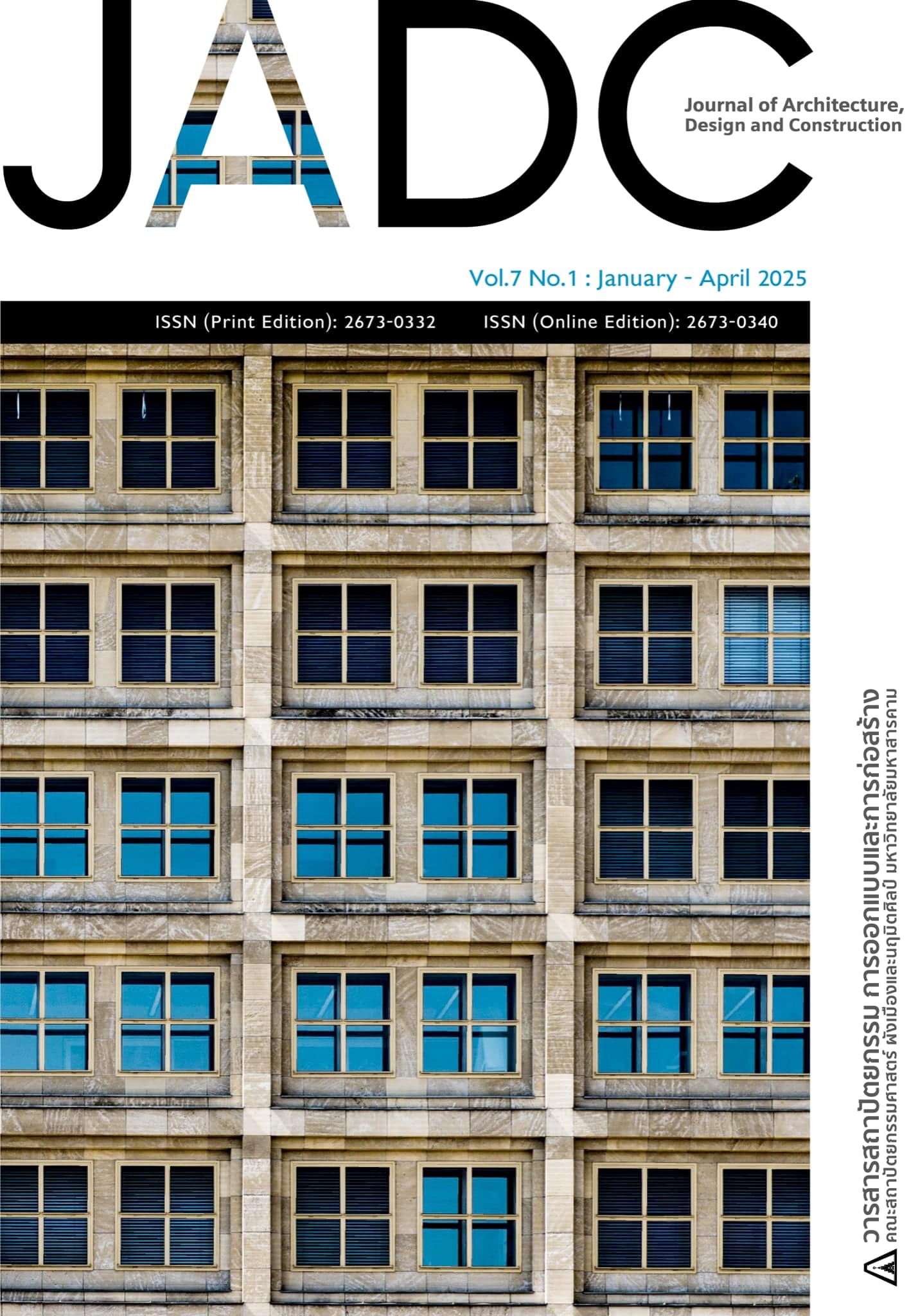The Design of Cultural Space in Participation of Koh Kret Village Moo 1 community, Nonthaburi
Main Article Content
Abstract
The objective of this research is to develop design concepts for transforming tourist areas into cultural spaces through community collaboration while integrating architectural education to generate new knowledge. The research focuses on Village Moo 1 in Koh Kret, Nonthaburi Province. The methodology is divided into two phases: (1) studying and analyzing the area and community, conducting an elementary analysis of the data, and synthesizing social geography to formulate design concepts; and (2) summarizing concepts and design guidelines for cultural spaces through community collaboration. This study employs the concept of “cultural space” in the design process to enhance the physical environment of the community, making it more compatible with tourism demands. The findings of this research provide guidelines for creating cultural spaces that reflect the interaction between physical location, culture, and economy. The development should prioritize preserving the community’s unique identity through active participation, which influences the design of cultural spaces and community activities, including efforts to promote sustainable cultural tourism.
Downloads
Article Details

This work is licensed under a Creative Commons Attribution-NonCommercial-NoDerivatives 4.0 International License.
The articles published in the Journal of Architecture, Design, and Construction are the intellectual property of the Faculty of Architecture, Urban Planning, and Fine Arts, Mahasarakham University.
References
กรมการท่องเที่ยว. (2561). แผนยุทธศาสตร์พัฒนาการท่องเที่ยว พ.ศ.2561-2564 ของกรมการท่องเที่ยว . กรมการท่องเที่ยว. https://www.dot.go.th/storage/กลุ่มแผน/5V7jtvCF7hvNiPXPU7MOdT7giHiF1ZbRokN8nBVx.pdf
กาญจนา แสงลิ้มสุวรรณ และ ศรันยา แสงลิ้มสุวรรณ. (2555). การท่องเที่ยวเชิงมรดกวัฒนธรรมอย่างยั่งยืน. วารสารนักบริหาร, 32(4), 139–146.
การท่องเที่ยวแห่งประเทศไทย. (2565). สัมผัสเสน่ห์เกาะเกร็ด นนทบุรี. https://www.tourismthailand.org
จิตตินุช วัฒนะ. (2557). การศึกษาเพื่อกำหนดอัตลักษณ์ถนนวัฒนธรรม (ถนนคนเดิน) ของจังหวัดพิษณุโลก. วารสารวิทยาการจัดการและสารสนเทศศาสตร์, 7(2), 71–80.
ชมพูนุท คงพุนพิน (2561). การสรรค์สร้างพื้นที่สาธารณะชุมชนเมือง เพื่อส่งเสริมอัตลักษณ์เชิงสังคมอย่างยั่งยืน [ดุษฎีนิพนธ์ปรัชญาดุษฎีบัณฑิต, มหาวิทยาลัยธรรมศาสตร์]. http://ethesisarchive.library.tu.ac.th/thesis/2018/TU_2018_5716300024_10638_11303.pdf
ณัฐกานต์ เพ็งหาพันธ์. (2554). การพัฒนาศักยภาพด้านการท่องเที่ยวเชิงวัฒนธรรม อำเภอเชียงคาน จังหวัดเลย [วิทยานิพนธ์ปริญญาบริหารธุรกิจมหาบัณฑิต, มหาวิทยาลัยขอนแก่น]. http://tourismlibrary.tat.or.th/medias/KKU0069/KKU0069_fulltext.pdf
แดนชัย ไพรสณฑ์. (2557). การอนุรักษ์ภูมิทัศน์วัฒนธรรม กรณีศึกษา: ชุมชนเกาะเกร็ด จังหวัดนนทบุรี. วารสารวิชาการ Veridian, 7(2), 1477–1487.
สำนักงานคณะกรรมการพัฒนาการเศรษฐกิจและสังคมแห่งชาติ. (2561). ยุทธศาสตร์ชาติด้านการสร้างการเติบโตบนคุณภาพชีวิตที่เป็นมิตรต่อสิ่งแวดล้อม. สำนักงานคณะกรรมการพัฒนาการเศรษฐกิจและสังคมแห่งชาติ. https://www.ilaw.or.th/wp-content/uploads/2018/03/NS_Draftplan05-1.pdf
สำนักงานคณะกรรมการวัฒนธรรมแห่งชาติ กระทรวงวัฒนธรรม และ คณะสถาปัตยกรรมศาสตร์ มหาวิทยาลัยศิลปากร. (2550). แนวทางการจัดการภูมิทัศน์วัฒนธรรม. กรุงเทพฯ: คณะสถาปัตยกรรมศาสตร์ มหาวิทยาลัยศิลปากร.
องค์การบริหารส่วนตำบลเกาะเกร็ด. (2562). แผนการส่งเสริมการท่องเที่ยวเกาะเกร็ด ประจำปี พ.ศ. 2562 – 2565. องค์การบริหารส่วนตำบลเกาะเกร็ด. https://www.kohkred-sao.go.th/public/list/data/detail/id/75/menu/1196/page/1/catid/67
Creighton, J. L. (2005). The public participation handbook: Making better decisions through citizen involvement. Jossey-Bass.
Jackson, J. B. (1984). Discovering the vernacular landscape. Yale University Press.
Lynch, K. (1981). A theory of good city form. MIT Press.
Smith, L. (2006). Uses of heritage. Routledge.
UNESCO. (2003). Convention for the safeguarding of the intangible cultural heritage. UNESCO. https://ich.unesco.org/doc/src/15164-EN.pdf
UNESCO. (2013). Operational guidelines for the implementation of the World Heritage Convention. UNESCO. https://whc.unesco.org/archive/opguide13-en.pdf

